NVIDIA’s GeForce GTX 460: The $200 King
by Ryan Smith on July 11, 2010 11:54 PM EST- Posted in
- GPUs
- GeForce GTX 400
- GeForce GTX 460
- NVIDIA
Power, Temperature, & Noise
As we’ve discussed in previous articles, with the Fermi family GPUs no longer are binned for operation at a single voltage, rather they’re assigned whatever level of voltage is required for them to operate at the desired clockspeeds. As a result any two otherwise identical cards can have a different core voltage, which muddies the situation some. All of our GTX 460 cards have an idle voltage of 0.875v, while their load voltage is listed below.
| GeForce GTX 460 Load Voltage | |||||
| Ref 768MB | Ref 1GB | EVGA 768MB #1 | EVGA 768MB #2 | Asus 768MB | Zotac 1GB |
|
0.987v
|
1.025v
|
0.987v
|
1.000v
|
0.987v
|
1.000v
|
Our cards end up ranging from 0.975v to 1.025v, a variance of 0.05v. The 1GB cards with additional functional units on average require more voltage to operate, with the lowest of our samples requiring 1.0v. Otherwise 3 of our 4 768MB cards require 0.975v.
On a side note, since we’re using non-matching 1GB GTX 460s here for SLI testing, we’ve added an asterisk for all the power & temperature results. Our results should be very close to what a proper set of matching reference cards would get, but we can’t guarantee that.

We’ll start with idle temperatures. With an unofficial idle TDP in the 20W range, the GTX 460 series is fairly comparable to the Radeon 5850, but with a more breezy cooler. As a consequence we can see it edge out the rest of our cards here, with all of the open GTX 460s coming in at 34C for idle. Meanwhile the blower-based Zotac card comes in a hair warmer at 35C. Even with a blower, these end up being the coolest mid-range or better cards we have ever tested, besting even the Radeon 5850.
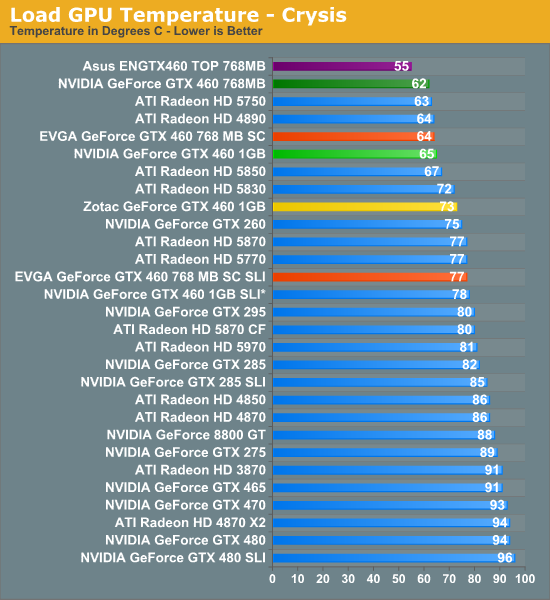
Meanwhile at load the good news continues for the GTX 460 series. The GTX 480 may have been a toasty GPU, but that’s not the case for the GF104 GPU at the heart of the GTX 460 series. Our reference cards do only slightly worse than 60C in Crysis, while Asus’s non-reference card gets that even lower thanks to a more proactive fan. Zotac’s blower doesn’t fare so well here though, coming in at a still respectable but nevertheless higher 73C.
Compared to AMD’s cards the GTX 460 does very well here. The Radeon 5850 is still the sweet spot for a balance of performance and heat, but the GTX 460 manages to do better in terms of heat at a price of lower gaming performance. Meanwhile our Radeon 5830 isn’t even a contender here; as a salvaged Cypress part, it just can’t compete with a part designed for cooler performance from the start. Among all the cards we’ve tested equal to or faster than the 8800GT however, the GTX 460 sets the new bar for how cool a high performance card can operate.
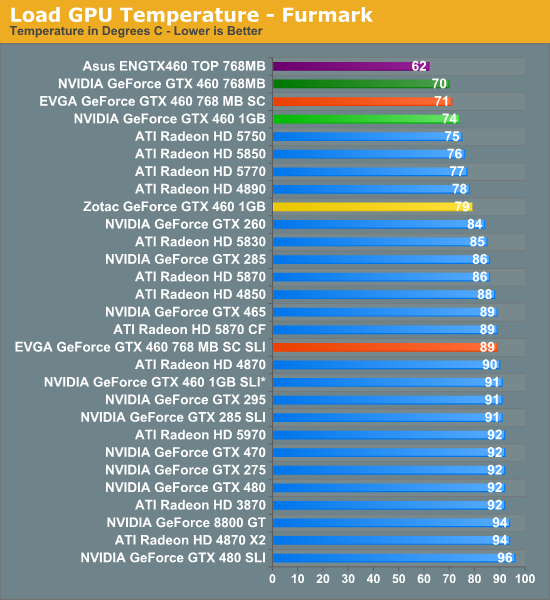
The results with Furmark match those of Crysis, it’s just a bit hotter. The interesting story here is going to be SLI temperatures: our 768MB and 1GB SLI cards hit 89C and 91C respectively. This isn’t a problem for NVIDIA’s GPUs (we see single GTX 480 cards do worse) but it’s a massive jump from a single card. For these reasons we would strongly suggest keeping these cards further spaced apart if you have a motherboard that supports it. The GTX 460 reference cooler just isn’t up to the task of pulling in fresh air if it’s next to another card.
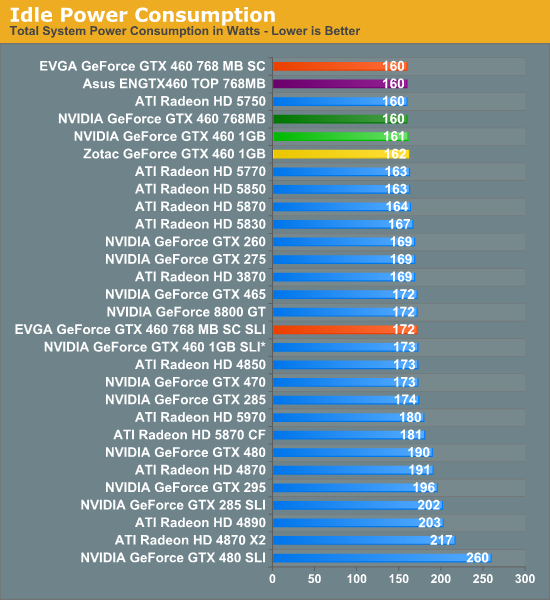
Our idle power numbers continue to lower the bar for GPUs of this performance class, although at this point we’re hitting the efficiency limits of our PSU at low wattages. Our 768MB GTX 460s end up sharing the 160W mark with the Radeon HD 5750, while for 1W more you have the 1GB cards.

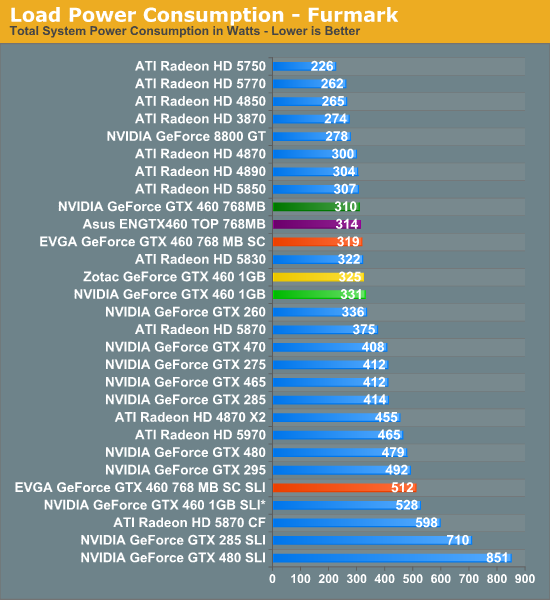
When looking at load power consumption, it’s always interesting to compare the power drawn with the temperatures. While the GTX 460 did very well here with regard to temperature, its power consumption reflects the fact that its GPU is still Cypress-sized. Under Crysis at a 280W load the 768MB part is comparable to the Radeon 5830 and the 1GB part adds around 10W to that. Meanwhile the Radeon 5850 manages to pull just a bit less power here, while the GTX 465 draws some 60W-70W more than the GTX 460. Gmae performance with those two cards may be close – power consumption is not.
As for Furmark the power consumption goes up but the ordering does not. Our 1GB cards now draw 20W more than 768MB cards, but the Radeon 5830 is still in the middle of the pack while the Radeon 5850 comes out ahead. The GTX 465 is now 80W-100W hotter than the GTX 460. Overall with a “proper” Radeon 5000 series card NVIDIA still can’t match AMD on a performance per watt basis, but they can come very close.

Finally we have our look at noise. With cool running cards we often have to look at fan noise to ensure that they aren’t accomplishing that trick by sounding like a jet engine, and in the case of the GTX 460 that’s clearly not the case. Besides being some of the coolest cards we’ve tested at this performance level the GTX 460 cards are also just as quiet as the rest of the best of the cards we’ve tested, hugging the 42dB sound floor in our testing environment. The 1GB reference card is marginally louder, while the partner customized cards are only slightly louder yet. The only card to really flop here is the Zotac GTX 460, which is at entirely the wrong end of our charts. Blowers can be quiet, but the Zotac’s is not – it’s simply a loud card. Unfortunately this kind of an idle noise level is going to put the card out of the running for a lot of buyers.
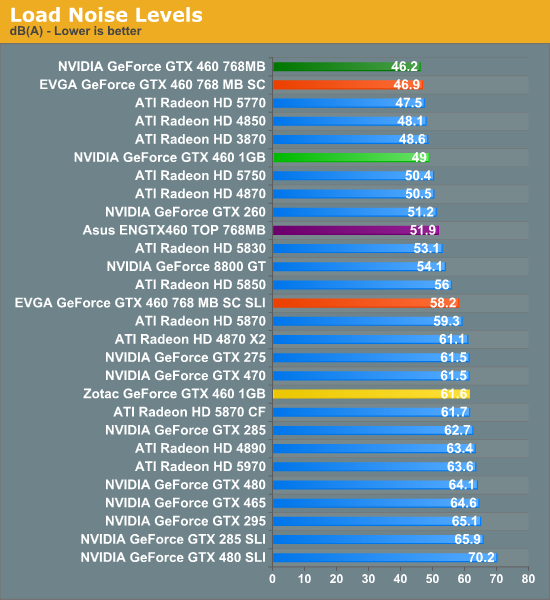
Load noise is more or less like our idle noise results. The 768MB GTX 460 registers the lowest result we’ve ever seen for a card of this performance level, coming in at 46.2dB and the EVGA card right behind it. The 1GB card does end up being louder (likely to compensate for cooling 2 more GDDR5 chips) but it’s still in good company. Asus’s card cracks 50dB, as it’s tuned for cooling over noise, explaining our earlier temperature results. Unfortunately the Zotac card is once again the odd man out at 61dB, roughly as loud as our GTX 470 is. It’s neither cooler than our reference cards nor quieter, which doesn’t bode well for this stock-clocked card.










93 Comments
View All Comments
san1s - Monday, July 12, 2010 - link
I hope this is the card that finally brings price drops, they have been stagnant for far too long.JGabriel - Monday, July 12, 2010 - link
It should. The 768MB version seems to perform about 5% better than the 5830, and the 1GB version comes to ~90% of the 5850.
Just on a performance per dollar basis, that means ATI should drop the 5830 to $189 max, with somewhere in the $170-$180 range being more reasonable, and the 5850 needs to drop down to about $249. Basically, we should be looking at 10%-20% price cuts for the 5670, 5750, 5770, 5830, and 5850.
It should force the GTX 470 under $300, too.
.
medi01 - Monday, July 12, 2010 - link
Best way to drop prices would be to ramp up production. Now, if what I've heard is true (fab treats nVidia as a preferred customer, unlike AMD) we will get yet another round of unfair competition, which in the end will hurt us, customers. :(PS
Is it me, or articles on this side seem quite a bit to be more positive on what nVidia does, than what would feel neutral? Marketing hints like "it’s not a simple reduced version of GF100 like what AMD did" all over... :(
jonup - Monday, July 12, 2010 - link
It is you! Only need to go to the GTX465 review to disptove your point.teohhanhui - Monday, July 12, 2010 - link
Giving credit where it is due?nafhan - Monday, July 12, 2010 - link
Ryan said that because the GF104 isn't a simple reduced version of GF100. Did you notice the part of the article where they talked about superscalar processing? That's not only a marketing bullet point, it's a pretty big change from an architecture point of view, too!medi01 - Tuesday, July 13, 2010 - link
And this detail brings what particular benefit to the user? In particular, contrasting it with competitors (otherwise superior, cooler and faster) solution? Someone makes something wrong, then he has to rework it (the competitor, that did it right from the beginning, doesn't) and this somehow makes he deserve "some credit"?Ben90 - Monday, July 12, 2010 - link
About that "marketing" comment about not a shrink of GF100, its completely true and how does that make this site pro-NVIDIA?You should check out the next article; very first paragraph:
"In 2007 we reviewed NVIDIA’s GeForce 8800 GT. At the time we didn’t know it would be the last NVIDIA GPU we would outright recommend at launch."
medi01 - Tuesday, July 13, 2010 - link
It's completely true, yet it is confusing at best. Piece of silicon is "praised" for something, that has no practical value to the consumer.And please, don't compare nVidia article to nVidia article, compare it to AMD:
When 5830 was reviewed, and mind you, it's a nice card that runs cooler, has eyefinity, but is a tad slower than older 49xx, this fact was PUT INTO TITLE, mind you. It was mentioned in the very NAME of the article, that new 200$ card is a tad slower than older ones. (basically the only "bad thing" that one could say about the card)
In case of 465 it's barely mentioned "oh, it's slower than older 200$ cards".
=(
Lonyo - Tuesday, July 13, 2010 - link
Anandtech is a tech site that often goes more into the under the hood bits.On some sites you will see them calculating performance per currency numbers, or performance per watt.
On Anandtech you will have them discussing things like changes to the architecture, the way the threading works etc.
That's not a new thing, and it's not a biased thing, that's just what they do here at AT in their reviews. It just so happens that the GTX460 has some of those under the hood changes compared to the earlier cards based on the same architecture, so they are discussed in the article.
If you don't care too much about that sort of thing, you can just skip to the benchmarks. If you are interested in it, then it's a nice addition.